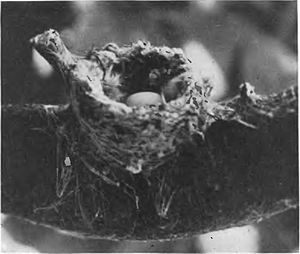had difficulty in securing a foothold and generally dropped to the ground. It made no attempt to escape when picked up and when finally replaced in the nest, as an experiment, it settled itself contentedly and remained there for about 24 hours, leaving when I approached the nest the next evening. At that time its flight was stronger and it seemed well able to care for itself.
For purposes of comparison I noted the approximate time spent in the nest by the young of several common birds nesting at about this same time. These were the House Finch (five nests), Green-backed Goldfinch, Western Lark Sparrow, Anthony Brown Towhee (two nests) and Western Mockingbird. The length of time ranged from 10 to 16 days, the longest in the case of the Mockingbird and perhaps one of the Linnets, the shortest for the Lark Sparrow and Towhee, which probably left their nests rather prematurely. These figures are

Fig. 46. Nest (no. 2) of Costa Hummingbird. Azusa, California, May 19, 1922.
not intended to be accurate, but they are in all cases considerably less than the 20 days which the Hummingbirds required. The corresponding period for the brood observed the previous year was not determined exactly, but I believe it to have been 22 or 23 days. On June 2, 1922, I found another Costa Hummingbird building a nest near the end of a long horizontal limb of a good-sized avocado tree, at a height of about five feet from the ground. Her method was first to alight in the nest then place the material under her (figure 48) and compact it by treading with the feet and turning about. Material for the outside of the nest was placed while hovering or while perched on a branch. On one occasion after leaving the nest the bird flew up to a twig a few feet above, whereupon I was surprised to see another hummer alight in the nest and rearrange some of the material, after-
